brake sensor Seat Leon 5D 2011 Owner's manual
[x] Cancel search | Manufacturer: SEAT, Model Year: 2011, Model line: Leon 5D, Model: Seat Leon 5D 2011Pages: 302, PDF Size: 4.17 MB
Page 80 of 302
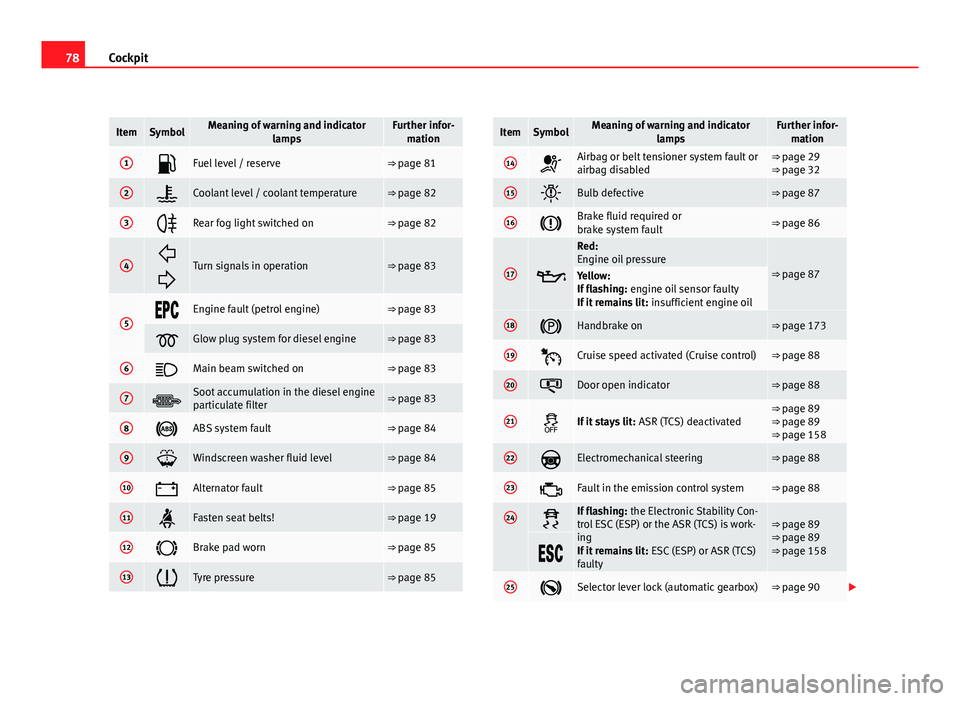
78Cockpit
ItemSymbolMeaning of warning and indicator
lampsFurther infor-mation
1’āāFuel level / reserveŌćÆŌĆŖpage 81
2’é┐Coolant level / coolant temperatureŌćÆŌĆŖpage 82
3’ƬRear fog light switched onŌćÆŌĆŖpage 82
4’Ć¼
’ĆŁTurn signals in operationŌćÆŌĆŖpage 83
5’üģ’üÉ’üāEngine fault (petrol engine)ŌćÆŌĆŖpage 83
’üżGlow plug system for diesel engineŌćÆŌĆŖpage 83
6’ĆżMain beam switched onŌćÆŌĆŖpage 83
7’āĘSoot accumulation in the diesel engine
particulate filterŌćÆŌĆŖpage 83
8’ü¬ABS system faultŌćÆŌĆŖpage 84
9’ü╣Windscreen washer fluid levelŌćÆŌĆŖpage 84
10’ü”Alternator faultŌćÆŌĆŖpage 85
11’é¬Fasten seat belts!ŌćÆŌĆŖpage 19
12’ü®Brake pad wornŌćÆŌĆŖpage 85
13’āćTyre pressureŌćÆŌĆŖpage 85
ItemSymbolMeaning of warning and indicator lampsFurther infor-mation
14’ü┤Airbag or belt tensioner system fault or
airbag disabledŌćÆŌĆŖpage 29
ŌćÆŌĆŖpage 32
15’ĆĮBulb defectiveŌćÆŌĆŖpage 87
16’ü©Brake fluid required or
brake system faultŌćÆŌĆŖpage 86
17’üź
Red:
Engine oil pressure
ŌćÆŌĆŖpage 87Yellow:
If flashing: engine oil sensor faulty
If it remains lit: insufficient engine oil
18’ü¦Handbrake onŌćÆŌĆŖpage 173
19’üØCruise speed activated (Cruise control)ŌćÆŌĆŖpage 88
20’é┤Door open indicatorŌćÆŌĆŖpage 88
21’é½If it stays lit: ASR (TCS) deactivatedŌćÆŌĆŖpage 89
ŌćÆŌĆŖpage 89
ŌćÆŌĆŖpage 158
22’ü║Electromechanical steeringŌćÆŌĆŖpage 88
23’üĖFault in the emission control systemŌćÆŌĆŖpage 88
24’āČIf flashing: the Electronic Stability Con-
trol ESC (ESP) or the ASR (TCS) is work-
ing
If it remains lit: ESC (ESP) or ASR (TCS)
faultyŌćÆŌĆŖpage 89
ŌćÆŌĆŖpage 89
ŌćÆŌĆŖpage 158
’üģ’üō’üā
25’ü½Selector lever lock (automatic gearbox)ŌćÆŌĆŖpage 90 ’éŻ
Page 87 of 302
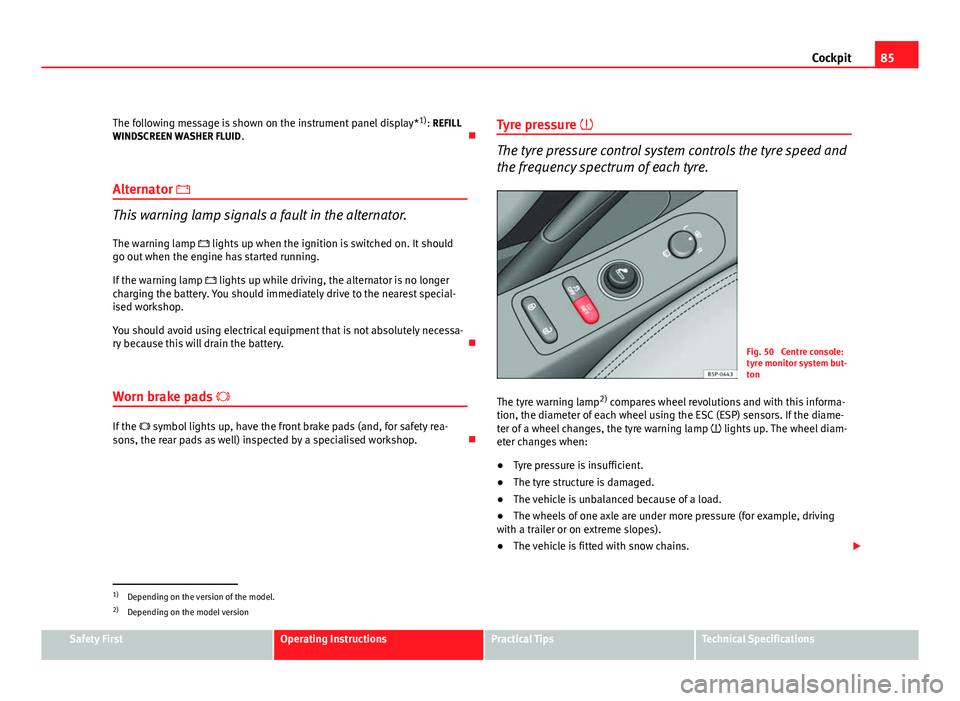
85
Cockpit
The following message is shown on the instrument panel display* 1)
: REFILL
WINDSCREEN WASHER FLUID . ’āÉ
Alternator ’ü”
This warning lamp signals a fault in the alternator.
The warning lamp ’ü” lights up when the ignition is switched on. It should
go out when the engine has started running.
If the warning lamp ’ü” lights up while driving, the alternator is no longer
charging the battery. You should immediately drive to the nearest special-
ised workshop.
You should avoid using electrical equipment that is not absolutely necessa-
ry because this will drain the battery. ’āÉ
Worn brake pads ’ü®
If the ’ü® symbol lights up, have the front brake pads (and, for safety rea-
sons, the rear pads as well) inspected by a specialised workshop. ’āÉTyre pressure ’āć
The tyre pressure control system controls the tyre speed and
the frequency spectrum of each tyre.
Fig. 50 Centre console:
tyre monitor system but-
ton
The tyre warning lamp 2)
compares wheel revolutions and with this informa-
tion, the diameter of each wheel using the ESC (ESP) sensors. If the diame-
ter of a wheel changes, the tyre warning lamp ’āć lights up. The wheel diam-
eter changes when:
ŌŚÅ Tyre pressure is insufficient.
ŌŚÅ The tyre structure is damaged.
ŌŚÅ The vehicle is unbalanced because of a load.
ŌŚÅ The wheels of one axle are under more pressure (for example, driving
with a trailer or on extreme slopes).
ŌŚÅ The vehicle is fitted with snow chains. ’éŻ
1)
Depending on the version of the model.
2) Depending on the model version
Safety FirstOperating InstructionsPractical TipsTechnical Specifications
Page 89 of 302
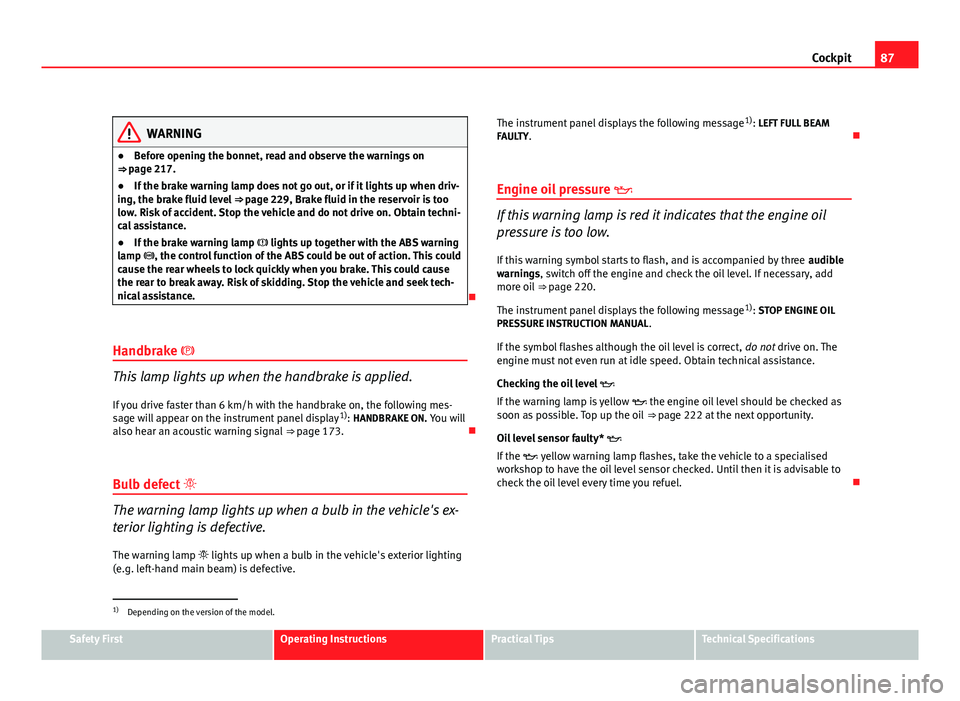
87
Cockpit
WARNING
ŌŚÅ Before opening the bonnet, read and observe the warnings on
ŌćÆŌĆŖpage 217.
ŌŚÅ If the brake warning lamp does not go out, or if it lights up when driv-
ing, the brake fluid level ŌćÆŌĆŖpage 229, Brake fluid in the reservoir is too
low. Risk of accident. Stop the vehicle and do not drive on. Obtain techni-
cal assistance.
ŌŚÅ If the brake warning lamp ’ü© lights up together with the ABS warning
lamp ’ü¬, the control function of the ABS could be out of action. This could
cause the rear wheels to lock quickly when you brake. This could cause
the rear to break away. Risk of skidding. Stop the vehicle and seek tech-
nical assistance.
’āÉ
Handbrake ’ü¦
This lamp lights up when the handbrake is applied. If you drive faster than 6 km/h with the handbrake on, the following mes-
sage will appear on the instrument panel display 1)
: HANDBRAKE ON. You will
also hear an acoustic warning signal ŌćÆŌĆŖpage 173. ’āÉ
Bulb defect ’ĆĮ
The warning lamp lights up when a bulb in the vehicle's ex-
terior lighting is defective.
The warning lamp ’ĆĮ lights up when a bulb in the vehicle's exterior lighting
(e.g. left-hand main beam) is defective. The instrument panel displays the following message
1)
: LEFT FULL BEAM
FAULTY. ’āÉ
Engine oil pressure ’üź
If this warning lamp is red it indicates that the engine oil
pressure is too low.
If this warning symbol starts to flash, and is accompanied by three audible
warnings, switch off the engine and check the oil level. If necessary, add
more oil ŌćÆŌĆŖpage 220.
The instrument panel displays the following message 1)
: STOP ENGINE OIL
PRESSURE INSTRUCTION MANUAL .
If the symbol flashes although the oil level is correct, do not drive on. The
engine must not even run at idle speed. Obtain technical assistance.
Checking the oil level ’üź
If the warning lamp is yellow ’üź the engine oil level should be checked as
soon as possible. Top up the oil ŌćÆŌĆŖpage 222 at the next opportunity.
Oil level sensor faulty* ’üź
If the ’üź yellow warning lamp flashes, take the vehicle to a specialised
workshop to have the oil level sensor checked. Until then it is advisable to
check the oil level every time you refuel. ’āÉ
1)
Depending on the version of the model.
Safety FirstOperating InstructionsPractical TipsTechnical Specifications
Page 186 of 302
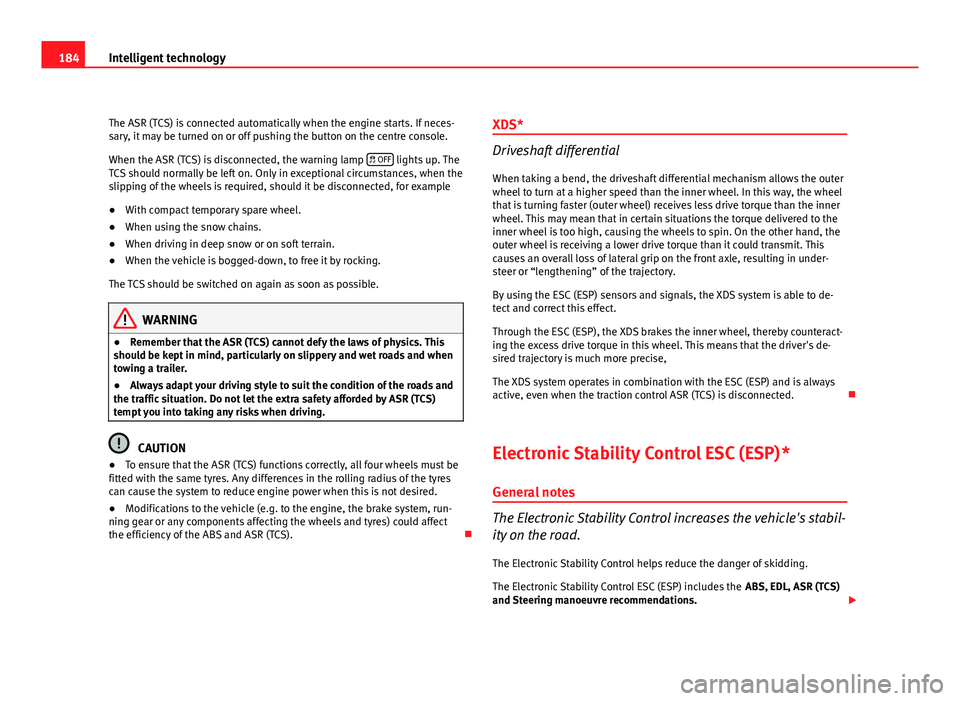
184Intelligent technology
The ASR (TCS) is connected automatically when the engine starts. If neces-
sary, it may be turned on or off pushing the button on the centre console.
When the ASR (TCS) is disconnected, the warning lamp ’āČ OFF
lights up. The
TCS should normally be left on. Only in exceptional circumstances, when the
slipping of the wheels is required, should it be disconnected, for example
ŌŚÅ With compact temporary spare wheel.
ŌŚÅ When using the snow chains.
ŌŚÅ When driving in deep snow or on soft terrain.
ŌŚÅ When the vehicle is bogged-down, to free it by rocking.
The TCS should be switched on again as soon as possible.
WARNING
ŌŚÅ Remember that the ASR (TCS) cannot defy the laws of physics. This
should be kept in mind, particularly on slippery and wet roads and when
towing a trailer.
ŌŚÅ Always adapt your driving style to suit the condition of the roads and
the traffic situation. Do not let the extra safety afforded by ASR (TCS)
tempt you into taking any risks when driving.
CAUTION
ŌŚÅ To ensure that the ASR (TCS) functions correctly, all four wheels must be
fitted with the same tyres. Any differences in the rolling radius of the tyres
can cause the system to reduce engine power when this is not desired.
ŌŚÅ Modifications to the vehicle (e.g. to the engine, the brake system, run-
ning gear or any components affecting the wheels and tyres) could affect
the efficiency of the ABS and ASR (TCS). ’āÉXDS*
Driveshaft differential
When taking a bend, the driveshaft differential mechanism allows the outer
wheel to turn at a higher speed than the inner wheel. In this way, the wheel
that is turning faster (outer wheel) receives less drive torque than the inner
wheel. This may mean that in certain situations the torque delivered to the
inner wheel is too high, causing the wheels to spin. On the other hand, the
outer wheel is receiving a lower drive torque than it could transmit. This
causes an overall loss of lateral grip on the front axle, resulting in under-
steer or ŌĆ£lengtheningŌĆØ of the trajectory.
By using the ESC (ESP) sensors and signals, the XDS system is able to de-
tect and correct this effect.
Through the ESC (ESP), the XDS brakes the inner wheel, thereby counteract-
ing the excess drive torque in this wheel. This means that the driver's de-
sired trajectory is much more precise,
The XDS system operates in combination with the ESC (ESP) and is always
active, even when the traction control ASR (TCS) is disconnected.
’āÉ
Electronic Stability Control ESC (ESP) *
General notes
The Electronic Stability Control increases the vehicle's stabil-
ity on the road. The Electronic Stability Control helps reduce the danger of skidding.
The Electronic Stability Control ESC (ESP) includes the ABS, EDL, ASR (TCS)
and Steering manoeuvre recommendations. ’éŻ
Page 187 of 302

185
Intelligent technology
Electronic Stability Control ESC (ESP)*
The ESC (ESP) reduces the danger of skidding by braking the wheels indi-
vidually.
The system uses the steering wheel angle and road speed to calculate the
changes of direction desired by the driver, and constantly compares them
with the actual behaviour of the vehicle. If the desired course is not being
maintained (for instance, if the vehicle is starting to skid), then the ESC
(ESP) compensates automatically by braking the appropriate wheel.
The forces acting on the braked wheel bring the vehicle back to a stable
condition. If the vehicle tends to oversteer, the system will act on the front
wheel on the outside of the turn.
Steering manoeuvre recommendations
This is a complementary safety function included in the ESC (ESP). This
function aids the driver to better stabilize the vehicle in a critical situation.
For example, in case of sudden braking surface with varied adherence, the
vehicle will tend to destabilise its trajectory to the right or to the left. In this
case the ESC (ESP) recognises the situation and helps the driver with a
counter steering manoeuvre from the power steering.
This function simply provides the driver with a recommended manoeuvre in
critical situations.
The vehicle does not steer itself with this function, the driver has full control
of the vehicle at all times.
WARNING
ŌŚÅ Remember that ESC (ESP) cannot defy the laws of physics. This
should be kept in mind, particularly on slippery and wet roads and when
towing a trailer.
ŌŚÅ Always adapt your driving style to suit the condition of the roads and
the traffic situation. Do not let the extra safety afforded by ESC (ESP)
tempt you into taking any risks when driving.
CAUTION
ŌŚÅ To ensure that the ESC (ESP) functions correctly, all four wheels must be
fitted with the same tyres. Any differences in the rolling radius of the tyres
can cause the system to reduce engine power when this is not desired.
ŌŚÅ Modifications to the vehicle (e.g. to the engine, the brake system, run-
ning gear or any components affecting the wheels and tyres) could affect
the efficiency of the ABS, EDL, ESC (ESP) and ASR (TCS). ’āÉ
Anti-lock brake system (ABS)
The anti-lock brake system prevents the wheels locking during braking
ŌćÆŌĆŖpage 183. ’āÉ
Electronic differential lock (EDL)*
The electronic differential lock helps prevent the loss of trac-
tion caused if one of the driven wheels starts spinning.
EDL helps the vehicle to start moving, accelerate and climb a gradient in
slippery conditions where this may otherwise be difficult or even impossi-
ble.
The system will control the revolutions of the drive wheels using the ABS
sensors (in case of an EDL fault the warning lamp for ABS lights up)
ŌćÆŌĆŖpage 84.
At speeds of up to approximately 80 km/h, it is able to balance out differen-
ces in the speed of the driven wheels of approximately 100 rpm caused by a
slippery road surface on one side of the vehicle. It does this by braking the
wheel which has lost traction and distributing more driving force to the oth-
er driven wheel via the differential. ’éŻ
Safety FirstOperating InstructionsPractical TipsTechnical Specifications
Page 254 of 302
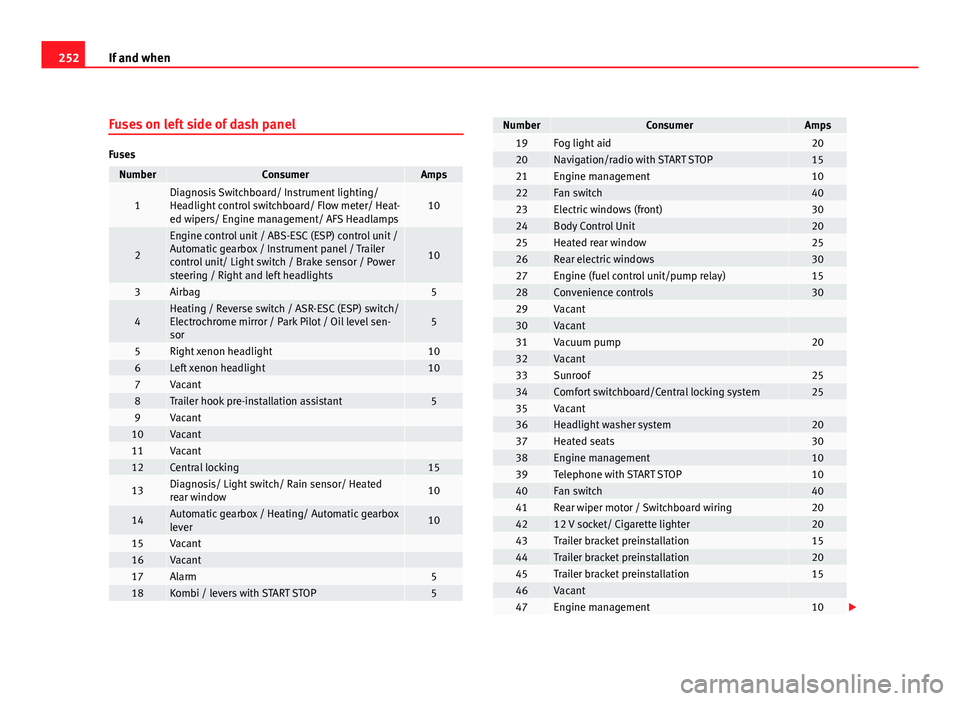
252If and when
Fuses on left side of dash panel
Fuses
NumberConsumerAmps
1Diagnosis Switchboard/ Instrument lighting/
Headlight control switchboard/ Flow meter/ Heat-
ed wipers/ Engine management/ AFS Headlamps10
2
Engine control unit / ABS-ESC (ESP) control unit /
Automatic gearbox / Instrument panel / Trailer
control unit/ Light switch / Brake sensor / Power
steering / Right and left headlights
10
3Airbag5
4Heating / Reverse switch / ASR-ESC (ESP) switch/
Electrochrome mirror / Park Pilot / Oil level sen-
sor5
5Right xenon headlight106Left xenon headlight107Vacant 8Trailer hook pre-installation assistant59Vacant 10Vacant 11Vacant 12Central locking15
13Diagnosis/ Light switch/ Rain sensor/ Heated
rear window10
14Automatic gearbox / Heating/ Automatic gearbox
lever10
15Vacant 16Vacant 17Alarm518Kombi / levers with START STOP5
NumberConsumerAmps19Fog light aid2020Navigation/radio with START STOP1521Engine management1022Fan switch4023Electric windows (front)3024Body Control Unit2025Heated rear window2526Rear electric windows3027Engine (fuel control unit/pump relay)1528Convenience controls3029Vacant 30Vacant 31Vacuum pump2032Vacant 33Sunroof2534Comfort switchboard/Central locking system2535Vacant 36Headlight washer system2037Heated seats3038Engine management1039Telephone with START STOP1040Fan switch4041Rear wiper motor / Switchboard wiring204212 V socket/ Cigarette lighter2043Trailer bracket preinstallation1544Trailer bracket preinstallation2045Trailer bracket preinstallation1546Vacant 47Engine management10’éŻ
Page 255 of 302
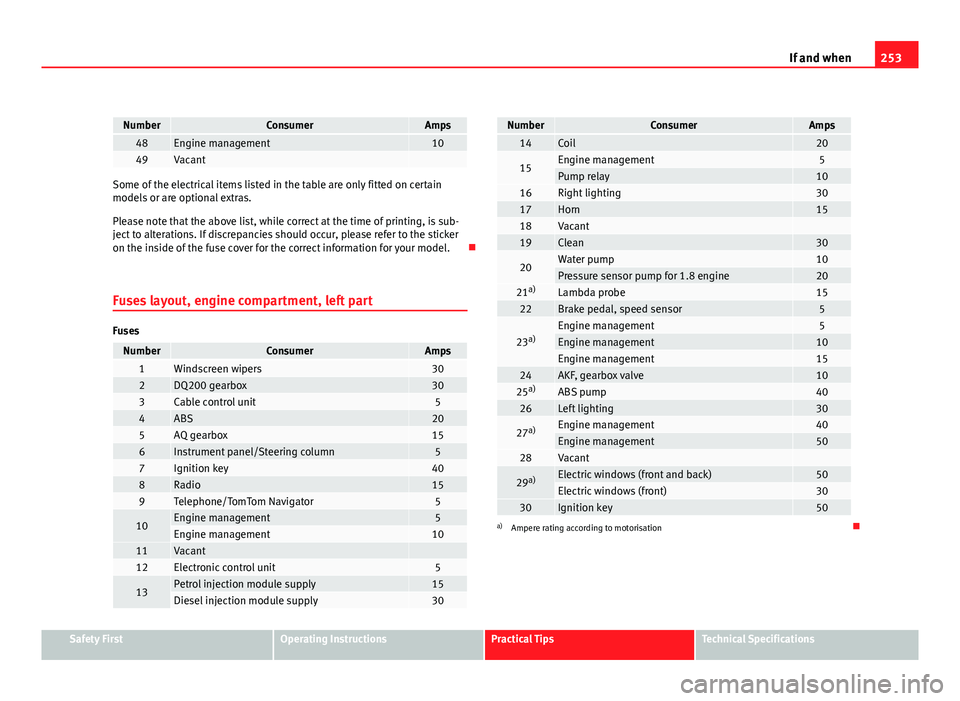
253
If and when
NumberConsumerAmps48Engine management1049Vacant
Some of the electrical items listed in the table are only fitted on certain
models or are optional extras.
Please note that the above list, while correct at the time of printing, is sub-
ject to alterations. If discrepancies should occur, please refer to the sticker
on the inside of the fuse cover for the correct information for your model. ’āÉ
Fuses layout, engine compartment, left part
Fuses
NumberConsumerAmps1Windscreen wipers302DQ200 gearbox303Cable control unit54ABS205AQ gearbox156Instrument panel/Steering column57Ignition key408Radio159Telephone/TomTom Navigator5
10Engine management5Engine management1011Vacant 12Electronic control unit5
13Petrol injection module supply15Diesel injection module supply30
NumberConsumerAmps14Coil20
15Engine management5Pump relay1016Right lighting3017Horn1518Vacant 19Clean30
20Water pump10Pressure sensor pump for 1.8 engine2021 a)Lambda probe1522Brake pedal, speed sensor5
23a)Engine management5Engine management10Engine management1524AKF, gearbox valve1025a)ABS pump4026Left lighting30
27a)Engine management40Engine management5028Vacant
29a)Electric windows (front and back)50Electric windows (front)3030Ignition key50a)
Ampere rating according to motorisation ’āÉ
Safety FirstOperating InstructionsPractical TipsTechnical Specifications